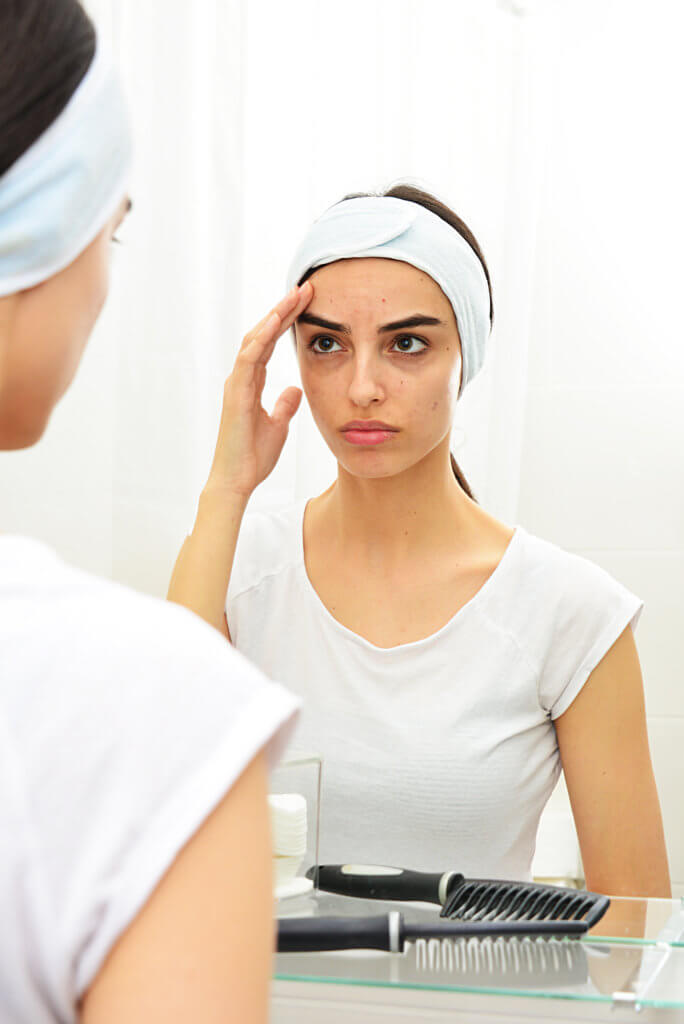If you’re a teen struggling with acne or the parent of a teen acne sufferer, managing acne treatments can feel overwhelming. The best way to help teens with acne is to work hard to prevent breakouts before they begin, but when teens head back to school each fall, this can be more difficult. The stress of a teen’s added responsibilities, engaging in sports, and lack of time for treatment can all contribute to more frequent acne breakouts. Keep reading to learn more about helping your teen prevent and treat acne even with their busy back to school schedules.
Causes of Teenage Acne
Teens with acne often struggle with self-esteem because they feel like they’re the only ones dealing with these issues, but this is simply not the case. Studies indicate that 40 to 50 million people in the U.S. struggle with acne. This common skin condition is caused by clogged pores. This begins with dead skin cells. Typically, these cells reach the surface of the pore, and they shed. When the body produces excess sebum (the oil that prevents dry skin), the dead cells will remain stuck inside the pore. Within these skin cells, there are bacteria, and they also get trapped in the pore. Inside this clogged pore, bacteria have the ideal environment for quick multiplication, which leads to inflammation, leaving skin red and swollen. Over time, the inflammation can cause the body to form a cyst. This is the fluid-filled bump that appears on the skin’s surface.
Grades & Types of Acne
If your teen struggles with acne, you should visit a dermatologist. They will diagnose the condition and determine the grade and type of acne. The grading system is numbered from one to four. Grade one is very mild and grade four is very severe with grades two and three being levels of moderate acne. There are also many different types of acne and determining which type(s) you have will help to guide proper treatment. Some of the most common forms of acne include:
- Acne vulgaris – the medical name for common acne that usually includes a variety of blackheads, whiteheads, and other types of pimples that most often appear on the face, chest, shoulders, and back.
- Comedones – the technical term for blackheads and whiteheads. Blackheads are open hair follicles that are clogged, and whiteheads are closed hair follicles that have clogged with oil and dead skin cells.
- Papules – are a form of comedo. These comedones have become inflamed. They can appear red or pink in color, and they are typically sensitive to the touch.
- Pustules – another type of inflamed comedone, pustules typically look like a white head with a red ring around them.
- Nodules – are large bumps that can become inflamed and feel hard to the touch. They develop deep below the skin and can be very painful.
- Cysts – are large bumps like nodules, but they are usually filled with pus and can be painful.
- Severe nodulocystic acne – the name for acne that causes numerous, inflamed cysts or nodules that can appear red or purple in color.
- Acne conglobata – is very severe, and it occurs when inflamed nodules are connected to other nodules below the skin.
- Acne mechanica – acne caused by friction or pressure against the skin it’s often the result of wearing a baseball cap or helmet. Thus, it has earned it the nickname “sports-induced acne.”
Preventing Teenage Acne
Because of the variation in type and severity, not every teenage acne treatment works for every person. However, with a good understanding of your unique condition, almost any case of acne can be controlled, and the most severe breakouts can often be prevented. A dermatologist can work with you to develop a plan that includes daily cleaning, medications, and/or in-office procedures. In most cases, this includes using products to eliminate bacteria and reduce oil production to avoid large, painful acne cysts. Developing a preventive plan is essential, but it won’t deliver overnight results. At-home treatments for acne can take one or two months to be most effective. Once they achieve clear skin, your teen has to keep up with a daily at-home routine to prevent breakouts.
Acne Treatment for Teens
There are a number of different methods for treating acne, including the following:
Topical Treatments
Topical cleansers and ointments are the most common, and they are necessary for the treatment of all levels of acne. Your teen’s topical acne treatments may contain a number of essential products like:
- Retinoids are effective both in unclogging pores and removing dead cells to prevent clogged pores.
- Benzoyl peroxide is used to reduce bacteria on the skin in order to eliminate and prevent clogged pores.
- Topical antibiotics and anti-inflammatories are also used to reduce skin bacteria and eliminate redness and inflammation.
- Salicylic acids may also be used to remove dead skin cells and prevent the clogging of pores.
Medications
In addition to topical solutions, a dermatologist may recommend you take a medication that works throughout the body, especially if you have very painful, red, or swollen forms of acne that leads to large acne cysts.
- Oral antibiotics may be prescribed to reduce inflammation and destroy bacteria.
- Birth control pills and medicines that control hormonal fluctuation can be helpful for women with acne.
- For the most severe cases, isotretinoin may be an option. This medication is derived from Vitamin A, and it can be beneficial for cases of acne that have not responded to other treatments. One course of treatment can take four to five months, but treatment using isotretinoin typically leads to long term and possibly even permanent clearance.
Dermatological Procedures
In addition to continued at-home care using topical and medicinal treatments, your dermatologist may also recommend procedures that need to be performed in the office. Some of the most common acne procedures include:
- Laser or light therapy – that can be used to reduce the numbers of bacteria on the skin to prevent and treat current acne breakouts.
- Professional chemical peels – many retailers sell “chemical peels,” but these are not the same as the procedure performed by your dermatologist. A professional chemical peel is often recommended for patients with blackheads or papules acne.
- Professional acne removal – often referred to as “drainage and extraction,” acne removal is necessary for large cysts or nodules that do not respond to topical or medicinal treatments. Professional removal helps to relieve pain and reduce the risk of scarring.
10 Tips to Get Rid of Teenage Acne Breakouts
During an acne breakout, there are some simple steps you can take to achieve skin clarity quickly. Below, you’ll find ten tips we give for clearing up teenage acne breakouts.
1 – Wash Your Face Twice a Day
You should wash your face using a gentle cleanser in the morning and at night. You may want to use products that contain retinoids, salicylic acid, benzoyl peroxide, or antibiotics as directed by your dermatologist.
2 – Wash After Exercise or Sweating
In addition to your twice daily face washing, you should wash your face after you exercise or sweat. This will help to prevent your pores from clogging.
3 – Only Use Your Hands to Apply Cleanser
Many people are tempted to use abrasive cleansers or mesh to remove acne, but this can actually irritate and inflame your skin. You should use only your hands to apply a nonabrasive cleanser.
4 – Do NOT Scrub Skin
Like using abrasive cleansers or applicators, scrubbing your skin can cause inflammation and irritation. Gently rub cleanser across your skin and remove it with water.
5 – Rinse with Warm Water
Use cool or warm water to clean acne. Hot water can cause discomfort or increased inflammation.
6 – Don’t Pop Your Acne
It will take longer to for your acne breakout to clear up if you pop, pick, or squeeze your acne, and this also significantly increases your risk for getting acne scars.
7 – Don’t Touch Your face
Oils on your hands can transfer onto your face, leading to flareups or further clogging pores.
8 – Stay Out of the Sun
Natural or synthetic tanning is another teen habit that can cause acne breakouts to worsen. Tanning damages your skin, and some acne medications cause sensitivity to UV rays.
9 – Pick the Right Products
A dermatologist can help you find the right topical and oral products to prevent and relieve teen acne breakouts at home.
10 – Consult Your Dermatologist
Finally, if you’re struggling with teenage acne, you should schedule an appointment to see one of the skilled professionals at U.S. Dermatology Partners. We’ll partner with you to develop and maintain a good at-home routine to prevent acne breakouts. If you’re not able to clear up a current breakout with at-home care, we can also provide in-office procedures to clear the skin. If you want to find out more about treatments for teenage acne, you can complete our simple online form to request an appointment with one of our skilled professionals.
Find a location near me
or


